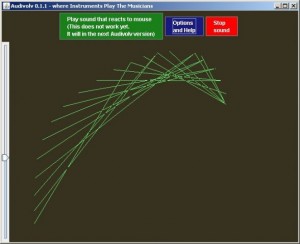Audivolv
O. James Samson - July 9, 2009 Audivolv is very interesting software simply because its purpose is to allow users to have more interaction with music. This Java-based application is practically a sample of artificial intelligence (AI) wherein constant interaction with the application will eventually help the application to fully comprehend your musical preferences.
Audivolv is very interesting software simply because its purpose is to allow users to have more interaction with music. This Java-based application is practically a sample of artificial intelligence (AI) wherein constant interaction with the application will eventually help the application to fully comprehend your musical preferences.
The application has limited commands which will be ignored when the application picks up the user preferences. The most prominent commands are “Sounds Good” and “Sounds Bad”. When the user reacts to the music by clicking any of the commands, the application reacts accordingly through colorful lines. After a few songs, the application will practically run by itself. Your previous commands will be taken as a sample of your preferences.
Since the application needs to learn your preferences first before it can be automated, the application will first use the electricity used in each speaker. As the music plays, you choose which part “Sounds good” and “Sounds bad”. The application will eventually learn your preferences and react accordingly on other songs.
An impressive function of Audivolv is the mouse interaction. Users can start the audio with simple mouse movements within the application. As the application continues to interpret the music, your mouse can be used to further control the reaction.
The obvious downside of the application is its practicality. While it’s impressive that you’ll be able to teach an application to interpret music, the application has no additional usability. Although it will require JRE (Java Runtime Environment) the possibility of an AI in Java-based application is a very impressive feat and a great way to interact with an application.
Check it out at codesimian.com
This entry was posted on Thursday, July 9th, 2009 at 7:19 am and is filed under Main. You can follow any responses to this entry through the RSS 2.0 feed. You can skip to the end and leave a response. Pinging is currently not allowed.


October 9th, 2009 at 12:20 am
I have many websites. http://codesimian.com is one. http://audivolv.com is more relevant to my Audivolv software.
The picture is old (version 0.1.2) and the current version (0.1.6) is still a very early version.
Its open-source GNU GPL 2+, and that will still be true when I create a global AI network of Audivolvs to play better mouse-music.
The end goal of Audivolv, years from now, is “collective intelligence” of millions of people playing mouse-music on the internet, using mouse-music as a type of unconscious communication between AI and people, to form a larger mind.
http://en.wikipedia.org/wiki/Collective_intelligence
I’ll copy/paste something I wrote on kurzweilai.net about it:
What does Audivolv do now?
* Starts with 1 click, assuming you have Java.
* Sound reacts instantly to mouse movement.
* You move the mouse any way you like and think about how that should sound.
* You choose “Sounds Good” or “Sounds Bad”.
* Audivolv tries to learn what you were thinking.
* Repeat until your musical thoughts become real.
* Close Audivolv and start over if you confuse it too much.
* Audivolv is a Java software that creates Java software to change things about itself as it learns
* Learns techno music faster than any other type, but what did you expect an AI to play first?
* There is not 1 line of music code in Audivolv until you teach it what music is. Then it writes the code.
* Find all new musical instruments in the “Audivolving” folder it creates, and copy/paste whats in those files into the “Create Musical Instrument” tab in the options, to play them again.
What will Audivolv do years from now?
* The same thing it does now but it learns faster, and will learn what you like with no good/bad buttons.
* Play all types of music and create new types.
* Given examples of the best known AI algorithms (bayesian net, neural net, evolution, etc) rewritten in Audivolv’s simpler code and data format, Audivolv will evolve an intelligent way to design and use new AI algorithms in that same format.
* Audivolv evolves a way to intelligently design AI brainwaves and data structures it will flow through and modify.
* Audivolv designs a different music-and-mouse language between AI and each person who plays music with their mouse.
* A new kind of communication: Audivolv translates between those music-and-mouse languages (no text) between millions of people across the Internet.
THEORETICALLY, AND I MEAN VERY THEORETICALLY, what could Audivolv possibly do years from now?
* Experiment with, and design Intelligence Amplification and Coherent Extrapolated Volition algorithms.
* Having a complete path between the mouse, speakers, and psychology of each person using the “Audivolv Network”, and limited to the bandwidth of mouse movements and speakers, any 2 people should be able to communicate thoughts directly and more efficiently than talking or typing on a keyboard.
* The first Artificial General Intelligence (AGI), still running only in Audivolv’s code and data format, communicating to other Audivolvs on the Internet, but each Audivolv rejects all dangerous code it receives by using its code-string-firewall.
* It will look almost the same as Audivolv does today, and you will still use it by playing music with the mouse, but with advanced realtime psychology, communicates 3d shapes and other information, similar to how you “hear the shape of a drum” ( http://en.wikipedia.org/wiki/Hearing_the_shape_of_ a_drum ). Today we think searching videos by patterns of color (instead of text) is advanced. Instead of text, video, or sound, you would search the “Audivolv Network” for ideas. Just think your search query while playing mouse-music however feels right at the time.